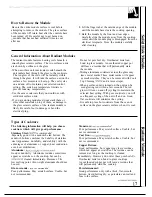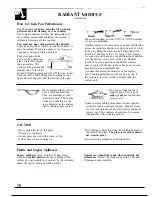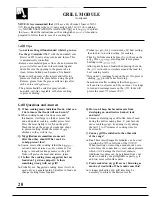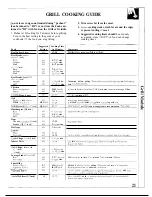
IMPORTANT SAFETY INSTRUCTIONS
(continued)
Self-Cleaning Oven
Do not clean the oven door gasket. The door
gasket is essential for a good seal. Care should be
taken not to rub,
or move the gasket.
●
Do not use oven cleaners. No commercial oven
cleaner or oven liner protective coating of any kind
should be used in or around any part of the oven.
Residue from oven cleaners will
the inside
of the oven when the self-clean
is used.
●
Clean only parts listed in this Use and Care
Guide.
●
Before self-cleaning the oven, remove the
broiler pan, rack and other cookware. Do not
self-clean the modules in the oven.
Be sure to wipe up excess spillage before
starting the self-cleaning operation.
●
If the self-cleaning mode malfunctions, turn
the oven off and disconnect the power supply.
Have it serviced by a qualified technician.
Surface Cooking Modules
●
Use proper pan size—Select cookware having
flat bottoms large enough to cover the surface unit
heating element. The use of undersized cookware
will expose a portion of the surface unit to direct
contact and may result in ignition of clothing.
Proper relationship of cookware to surface unit
will also improve efficiency.
●
Never leave the kitchen while using the grill.
●
Never leave the modules unattended at high
heat settings.
cause smoking and
greasy spillovers that may catch on fire.
●
Be sure the drip pans (on some modules) and
the vent grills are not covered and are in place.
Their absence during cooking could damage range
parts and wiring.
●
Do not use aluminum foil to line the drip
pans (on some modules) or anywhere in the
oven except as described in this guide. Misuse
could result in a shock, fire hazard or damage
to the range.
●
Only certain types of glass, glass/ceramic,
earthenware or other glazed containers are
suitable for cooktop service; others may break
because of the sudden change in temperature.
To minimize the possibility of burns, ignition
of flammable materials, and spillage, the handle
of a container should be turned toward the center
the
without extending over the nearby
surface units.
●
turn the module controls off before
removing the cookware.
●
To avoid the possibility of a burn or electric
shock, always be certain that the controls for all
surface units are at the off position and all surface
units are cool before attempting to remove a
surface unit or a module.
Never clean the cooktop surface when it is hot.
Some cleaners produce noxious fumes and wet
cloths could cause steam burns if used on a hot
surface.
●
Keep an eye on foods being fried at high or
medium high heat settings.
●
Do not immerse or soak the removable
modules and surface units. Do not put them
in a dishwasher. Do not self-clean the modules
in the oven.
●
When flaming foods are under the hood, turn
the fan off. The fan, if operating, may spread
the flame.
●
Foods for frying should be as dry as possible.
Frost on frozen foods or moisture on fresh foods
can cause hot fat to bubble up and over the sides
of the pan.
●
Use little fat for effective shallow or deep-fat
frying. Filling the pan too full of fat can cause
spillovers when food is added.







































